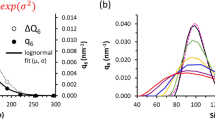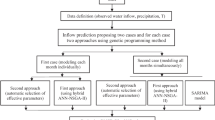Abstract
Based on the mechanism of chromatographic retention (the relationship between the retention of solute and the mobile phase conditions) and method of resolution map, several methods of optimizing multi-segment linear gradient elution conditions were proposed according to the different separation requirements of various samples. These methods were verified using literature data. Moreover, the advantages and disadvantages of these methods were compared. It was proved that the third method is a fast optimization method which is capable of separating all the components with relatively high resolution.
Similar content being viewed by others
References
Schmidt A H, Molnar I. Computer-assisted optimization in the development of a high-performance liquid chromatographic method for the analysis of kava pyrones in Piper methysticum preparations. J Chromatogr A, 2002, 948: 51–63
Liu C L, Zhu P L, Liu M C. Computer-aided development of a high-performance liquid chromatographic method for the determination of hydroxyanthraquinone derivatives in Chinese herb medicine rhubarb. J Chromatogr A, 1999, 857: 167–174
Wolcott R G, Dolan J W, Snyder L R. Computer simulation for the convenient optimization of isocratic reversed phase liquid chromatographic separations by varying temperature and mobile phase strength. J Chromatogr A, 2000, 869: 3–25
Markowski W. Computer-aided optimization of gradient multiple development thin-layer chromatography (III): Multi-stage development over a constant distance. J Chromatogr A, 1996, 726: 185–192
Markowski W. Computer-aided optimization of gradient multiple development thin-layer chromatography (II): Multi-stage development. J Chromatogr A, 1993, 635: 283–289
Wrisley L. Use of computer simulations in the development of gradient and isocratic high-performance liquid chromatography methods for analysis of drug compounds and synthetic intermediates. J Chromatogr A, 1993, 628: 191–198
Chloupek R C, Hancock W S, Snyder L R. Computer simulation as a tool for the rapid optimization of the high-performance liquid chromatographic separation of a tryptic digest human growth hormone. J Chromatogr A, 1992, 594: 65–73
Baba Y, Kura G. Computer-assisted retention prediction system for inorganic cyclic polyphosphates and its application to optimization of gradients in anion-exchange chromatography. J Chromatogr A, 1991, 550: 5–14
Baba Y, Ito M K. Optimization of gradients in anion-exchange separations of oligonucleotides using computer-assisted retention prediction and a high-performance liquid chromatographic simulation system. J Chromatogr A, 1989, 485: 647–655
Dzido T H, Soczewinski E, Gudej J. Computer-aided optimization of high-performance liquid chromatographic analysis of flavonoids from some species of the genus. J Chromatogr A, 1991, 550: 71–76
Schoenmakers P J, Bartha A, Billiet H A H. Gradient elution methods for predicting isocratic conditions. J Chromatogr A, 1991, 550: 425–447
Jandera P. Predictive calculation methods for optimization of gradient elution using binary and ternary solvent gradients. J Chromatogr A, 1989, 485: 113–141
Jandera P. Gradient elution in normal-phase high-performance liquid chromatographic systems. J Chromatogr A, 2002, 965: 239–261
Jandera P. Optimisation of gradient elution in normal-phase high-performance liquid chromatography. J Chromatogr A, 1998, 797: 11–22
Nikitas P, Pappa-Louisi A, Papachristos K. Optimisation technique for stepwise gradient elution in reversed-phase liquid chromatography. J Chromatogr A, 2004, 1033: 283–289
Vivó-Truyols G, Torres-Lapasió J R, García-Alvarez-Coque M C. Enhanced calculation of optimal gradient programs in reversed-phase liquid chromatography. J Chromatogr A, 2003, 1018: 183–196
Gallant S R, Vunnum S, Cramer S M. Optimization of preparative ion-exchange chromatography of proteins: Linear gradient separations. J Chromatogr A, 1996, 725: 295–314
Lundell N. Implementation and use of gradient predictions for optimization of reversed-phase liquid chromatography of peptides: Practical considerations. J Chromatogr A, 1993, 639: 97–115
Morris V, Hughes J, Marriott P. Spherical coordinate representations of solvent composition for liquid chromatography method development using experimental design. J Chromatogr A, 2003, 1008: 43–56
Jandera P. Simultaneous optimisation of gradient time, gradient shape and initial composition of the mobile phase in the high-performance liquid chromatography of homologous and oligomeric series. J Chromatogr A, 1999, 845: 133–144
Concha-Herrera V, Vivó-Truyols G, Torres-Lapasió J R, García-Alvarez-Coque M C. Limits of multi-linear gradient optimization in reversed-phase liquid chromatography. J Chromatogr A, 2005, 1063: 79–88
Dolan J W, Snyder L R, Blanc T, Heukelem L V. Selectivity differences for C18 and C8 reversed-phase columns as a function of temperature and gradient steepness (I): Optimizing selectivity and resolution. J Chromatogr A, 2000, 897: 37–50
Dolan J W, Snyder L R, Djordjevic N M, Hill D W, Waeghe T J. Reversed-phase liquid chromatographic separation of complex samples by optimizing temperature and gradient time (I): Peak capacity limitations. J Chromatogr A, 1999, 857: 1–20
Dolan J W, Snyder L R, Djordjevic N M, Hill D W, Waeghe T J. Reversed-phase liquid chromatographic separation of complex samples by optimizing temperature and gradient time (II): Two-run assay procedures. J Chromatogr A, 1999, 857: 21–39
Dolan J W, Snyder L R, Wolcott R G, Haber P, Baczek T, Kaliszan R, Sander L C. Reversed-phase liquid chromatographic separation of complex samples by optimizing temperature and gradient time (III): Improving the accuracy of computer simulation. J Chromatogr A, 1999, 857: 41–68
Dolan J W, Snyder L R, Djordjevic N M, Hill D W, Saunders D L, Heukelem L V, Waeghe T J. Simultaneous variation of temperature and gradient steepness for reversed-phase high-performance liquid chromatography method development (I): Application to 14 different samples using computer simulation. J Chromatogr A, 1998, 803: 1–31
Dolan J W, Snyder L R, Saunders D L, Heukelem L V. Simultaneous variation of temperature and gradient steepness for reversed-phase high-performance liquid chromatography method development (II): The use of further changes in conditions. J Chromatogr A, 1998, 803: 33–50
Li W, Rasmussen H T. Strategy for developing and optimizing liquid chromatography methods in pharmaceutical development using computer-assisted screening and Plackett-Burman experimental design. J Chromatogr A, 2003, 1016: 165–180
Molnar I. Computerized design of separation strategies by reversed-phase liquid chromatography: Development of DryLab software. J Chromatogr A, 2002, 965: 175–194
Lu P C, Zhang Y K, Liang X M. High Performance Liquid Chromatography and Expert System. Shenyang: Liaoning Science and Technology Press, 1992
Li R J. Intelligent optimization and chromatographic separation method development system. Dissertation for the Doctor Degree. Dalian Institute of chemical Physics, Chinese Academy of sciences, 1998
Shan Y C, Zhao R H, Zhang W B, Liang Z, Zhang Y K. Fast binary stepwise gradient optimization method for the separation of complex samples. Chinese Journal of Analytical Chemistry (in Chinese), 2002, 30(12): 1444–1447
Shan Y C, Zhao R H, Zhang W B, Liang Z, Zhang Y K. Optimization of ternary stepwise gradient elution conditions in RP-HPLC. Chinese Journal of Chromatography, 2002, 20(4): 289–294
http://www.rheodyne.com/products/chromatography/drylab/index.asp
Snyder L R, Kirkland J J, Glajch J L. Practical HPLC Method Development, 2nd ed. New York: John Wiley and Sons, 1997
Author information
Authors and Affiliations
Corresponding author
Rights and permissions
About this article
Cite this article
Shan, Y., Zhang, W., Seidel-Morgenstern, A. et al. Multi-segment linear gradient optimization strategy based on resolution map in HPLC. SCI CHINA SER B 49, 315–325 (2006). https://doi.org/10.1007/s11426-006-2004-y
Received:
Accepted:
Issue Date:
DOI: https://doi.org/10.1007/s11426-006-2004-y




